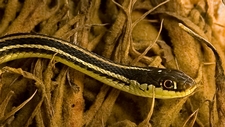Changes in Food Chains

TEKS Objective
The student is expected to identify and describe the flow of energy in a food chain and predict how changes in a food chain affect the ecosystem such as removal of frogs from a pond or bees from a field.
Essential Understanding
The student knows that organisms have characteristics that help them survive and can describe patterns, cycles, systems, and relationships within the environments.
Science Background
Food Chains, Changes to Food Webs: BBC Bitesize (website) - Answers to questions about the impact of changes that could (and do) occur within food chains and food webs. For example, what would happen if the population of slugs or insects decreased in a particular food chain?
What would happen if the grass died?
Food Chains, Changes to Food Webs
BBC Bitesize, http://www.bbc.co.uk/schools/ks3bitesize/
Species with a Large Impact on Community Structure:Scitable website) – Predators help to maintain a balance among the different organisms within an ecosystem. This article describes how predatros influence the composition and distribution of species in communities.
Species with a Large Impact on Community Structure
Scitable, http://www.nature.com/scitable/
Signature Lesson
Oh Deer: Nature Bridge (pdf) - In this active, competitive game, students experience how ecosystems are impacted by, and how they adapt over time in response to changes in the food chain and the availability of resources within their habitats.
- Supporting Lessons
- Extensions
- Assessment Ideas
- Literature Connections
- Related
TEKS - Additional Resources
Supporting Lessons
Food Chain Game: Anapsid.org (PDF) – Students investigate food chains and changes to populations over time by assuming the roles of animals that are part of a food chain.
Elaboration Lessons and Extensions
Experiment with Ecosystems: Concord Consortium (Software and PDF) - Engaging series of activities in which students experiment with, and make predictions about a variety of virtual ecosystem models, and test their hypotheses about producer/consumer and predator/prey relationships. Download the free software and teacher's guide.
Experiment with Ecosystems - Software Download
Concord Consortium, www.concord.org
Experiment with Ecosystems - PDF Teacher's Guide
Concord Consortium, www.concord.org
Assessment Ideas
Pond Water Web, Lesson Plan: Science Spot (PDF) - Assess students’ understanding of the flow of energy through a food chain by having them answer question 3 on page 5 of this activity.
Pond Water Web, Lesson Plan
Science Spot, http://sciencespot.net/
Literature Connections
Food Chains. Rau Meachen, Dana (ISBN-13: 978-0761440956)
Who Eats What? Food Chains and Food Webs. Lauber, P. and Keller, H. (ISBN-13: 978-0064451307)
What are Food Chains and Webs? Kalman, Bobbie (ISBN-13: 978-0778776376)
An Antarctic Habitat. Alonian, Molly. (ISBN-13: 978-0778729846)
Arctic and Antarctic. Mack, Lorrie (ISBN-13: 978-0756619800)
Additional Resources
Food Chains: BBC Bitesize (website) - Online video in which students explore components of food chains, how energy moves through food chains, and what happens to populations within a food chain if certain factors change.
Food Chains
BBC Bitesize, http://www.bbc.co.uk/schools/ks3bitesize/
TEKS Navigation
Grade 3
Need Assistance?
If you need help or have a question please use the links below to help resolve your problem.

Comments